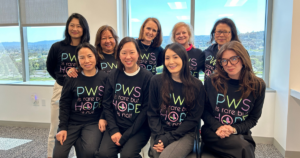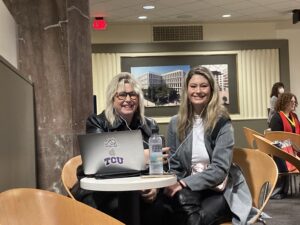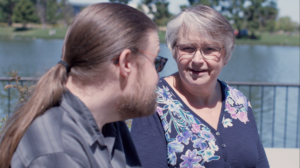Elaine and her son, Jim offer a unique perspective on life with Prader-Willi syndrome (PWS), sharing the milestones and hurdles their family has faced together. Jim’s journey exemplifies the strength and support that have been essential in helping him build a more independent and fulfilling life.
This family’s story highlights the courage and resilience of navigating PWS and the significance of a connected, supportive network in managing the challenges that come with the rare genetic condition. Their experiences show how vital awareness, understanding, and community resources are for families touched by PWS.
Jim’s Early Diagnosis and Challenges of Living With Prader-Willi Syndrome
As soon as Jim was born, he started exhibiting unusual symptoms, and doctors referred to the infant as “floppy.” Jim had extremely low muscle tone and difficulties with feeding. Jim was born in 1986, so these symptoms puzzled doctors since not much information was known about Prader-Willi syndrome at the time.
After several years without a formal diagnosis, a genetic test confirmed that Jim had PWS due to a deletion, a type of genetic mutation that contributes to the syndrome’s symptoms. For Elaine and the rest of the family, this diagnosis was a relief as they now had answers to the many questions they had around his symptoms.
Jim and Elaine’s journey sheds light on the daily complexities and evolving challenges of Prader-Willi syndrome, revealing the many ways families adapt to support a loved one living with this rare diagnosis.
Developing a Passion and Finding a Community
As a child growing up with Prader-Willi syndrome, Jim faced many physical challenges and limitations due to his low muscle tone, a common symptom associated with PWS. Watching other children play sports and engage in physical activities was difficult as he often felt limited by PWS.
A pivotal moment for Jim was discovering the Special Olympics. Through this community, he found activities like soccer, swimming, and snowshoeing that allowed him to participate and excel in his passions. The Special Olympics provided Jim not only with a chance to be active, but also a supportive community of peers also facing limiting conditions. This new passion and community helped Jim build confidence and a sense of belonging.
Navigating PWS Challenges in School
As Jim grew older, managing food security became an increasingly complex challenge. Elaine’s role as Jim’s advocate was essential as he began to move into environments where food access was less controlled, like high school and, later, college.
While in his younger years at home, Elaine and the family introduced locks on the pantries and refrigerators to limit Jim’s access to food. This adjustment was essential not only for Jim’s physical health but also for maintaining a sense of safety and structure in his life. She worked closely with school staff to ensure they understood his needs, educated friends and family about PWS, and found ways to address the challenges posed by an environment with more open access to food.
By building strong support networks around Jim, Elaine ensured that others could help keep him safe as he navigated these new challenges. Her proactive approach assisted Jim’s journey toward self-sufficiency, allowing him to balance independence with the security necessary for his well-being.
Moving Toward Adulthood with PWS: Creating a Safe and Supportive Environment
Jim’s move into adult independence began during his college years, a time that generated both excitement and new challenges. Elaine quickly noticed that although her son initially thrived in the academic environment, the transition to college came with unique difficulties, particularly around the access to food.
Living in the dorms proved to be an ongoing challenge due to this food freedom, which led to health problems and hospitalization. This setback highlighted the need for structured environments that could support Jim’s health and well-being while still respecting his desire for independence.
After returning home to recover, the family explored other options to provide a balanced lifestyle for Jim. This led them to Cape Cod, where a trusted family friend offered a unique living arrangement—an independent apartment within her home. Alongside his caregiver, Jim found a supportive, structured environment that allowed him to embrace adult life.
His caregiver prepares meals and manages his dietary needs while also coordinating healthcare appointments to ensure his daily life is stable and fulfilling. This setup now allows Jim the freedom to explore his interests, work, and build social connections while still having the structure essential for his well-being.
As Jim adapted to living more independently, he developed a stronger sense of responsibility and self-advocacy. This newfound autonomy was empowering, showing the family and everyone else around him that, with the right support and structure, people living with Prader-Willi syndrome can still lead fulfilling and independent lives.
After returning home to recover, the family explored other options to provide a balanced lifestyle for Jim. This led them to Cape Cod, where after two failed living arrangements, they were referred to someone that offered a unique living arrangement—an independent apartment within a caregiver’s home. Here Jim found a supportive, structured environment that allowed him to embrace adult life and his caregiver has become a trusted family friend.
Jim has now moved from the apartment in his caregiver’s home to a more independent apartment nearby. His caregiver continues to manage his dietary needs and prepare meals, while also coordinating healthcare appointments and helping to make his daily life stable and fulfilling. This setup allows Jim the freedom to explore his interests, actively participate in his community-based day program, and build social connections while still having the structure essential for his well-being.
As Jim adapted to living more independently, he developed a stronger sense of responsibility and self-advocacy. This newfound autonomy was empowering, showing the family and everyone else around him that, with the right support and structure, people living with Prader-Willi syndrome can still lead fulfilling and independent lives.
Encouragement to Embrace New Opportunities While Facing the Realities of Living with Prader-Willi Syndrome
Jim’s story is one of strength and courage, inspiring others with Prader-Willi syndrome to explore opportunities and work within limitations. From participating in the Special Olympics to playing hockey and swimming, Jim found ways to stay active, connect with others, and demonstrate that PWS doesn’t have to prevent him from enjoying life thoroughly.
Jim encourages others with PWS to try new things, even if they seem daunting, and to push their boundaries. His journey is a testament to the power of resilience, community, and determination.
For those seeking additional information and other inspiring stories, Support for Prader-Willi Syndrome provides valuable resources for individuals living with or caring for those with PWS.
Frequently Asked Questions
How common is Prader-Willi syndrome?
Prader-Willi syndrome affects males and females equally across all races, with prevalence estimates of 1 in 15,000.
What are the physical characteristics associated with Prader-Willi syndrome?
As a child with PWS grows, they can exhibit developmental delay, intellectual disability, excessive or rapid weight gain during childhood, and hyperphagia. Additional characteristics of PWS may include short stature, growth hormone deficiency, behavioral problems such as repetitive questioning, temper tantrums and stubbornness, autistic tendencies, skin picking, sleep abnormalities, and articulation defects.
What are the common symptoms of Prader-Willi syndrome
Every person living with Prader-Willi syndrome has a unique journey and can experience symptoms differently, however, a hallmark symptom that many may experience is persistent hunger, known as hyperphagia.


